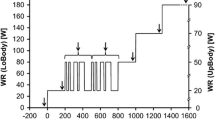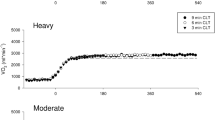Abstract
We hypothesized that oxygen consumption (V̇O2) rises incrementally in very heavy and fatiguing exercise where the slow component gain increases with higher work rates. Eight trained males completed a graded exercise test and bouts of square-wave cycle ergometry at 40% and 60% of the difference between the estimated lactate threshold (LT) and V̇O2peak (designated 40%D and 60%D). Exhaled gases were collected and analyzed every breath using models that allowed for a linear slow component or a slow component with one or more exponential increments. All subjects were able to complete 30 min at 40%D but not at 60%D. The slow component was generally best fit with two increments at 40%D and two or three increments at 60%D. In further (<Emphasis Type=”Italic”>, our results question the reliability of determining parameters of multiple slow component increments when repeated bouts are averaged together. This study demonstrates that V̇O2 can continue to rise incrementally beyond the onset of the slow component in very heavy and fatiguing exercise. These results support the concept of a recurring mechanism underlying the slow component of V̇O2 kinetics during square-wave exercise and suggest that the dynamics (time of onset, rate of development, magnitude) of this mechanism may vary from day to day.


Similar content being viewed by others
References
Barstow TJ, Molé PA (1991) Linear and nonlinear characteristics of oxygen uptake kinetics during heavy exercise. J Appl Physiol 71:2099–2106
Barstow TJ, Casaburi R, Wasserman K (1993) O2 uptake kinetics and the O2 deficit as related to exercise intensity and blood lactate. J Appl Physiol 75:755–762
Barstow TJ, Jones AM, Nguyen PH, Casaburi R (1996) Influence of muscle fiber type and pedal frequency on oxygen uptake kinetics of heavy exercise. J Appl Physiol 81:1642–1650
Bearden SE, Moffatt RJ (2000) VO2 kinetics and the O2 deficit in heavy exercise. J Appl Physiol 88:1407–1412
Beaver WL, Wasserman K, Whipp BJ (1986) A new method for detecting anaerobic threshold by gas exchange. J Appl Physiol 60:2020–2027
Brittain CJ, Rossiter HB, Kowalchuk JM, Whipp BJ (2001) Effect of prior metabolic rate on the kinetics of oxygen uptake during moderate-intensity exercise. Eur J Appl Physiol 86:125–134
Carra J, Candau R, Keslacy S, Giolbas F, Borrani F, Millet GP, Varray A, Ramonatxo M (2003) The addition of inspiratory resistance increases the amplitude of the slow component of the O2 uptake kinetics. J Appl Physiol 94:2448–2455
Carter H, Jones AM, Barstow TJ, Burnley M, Williams CA, Doust JH (2000) Oxygen uptake kinetics in treadmill running and cycle ergometry: a comparison. J Appl Physiol 89:899–907
Casaburi R, Barstow TJ, Robinson T, Wasserman K (1989a) Influence of work rate on ventilatory and gas exchange kinetics. J Appl Physiol 67:547–555
Casaburi R, Daly J, Hansen JE, Effros RM (1989b) Abrupt changes in mixed venous blood gas composition after the onset of exercise. J Appl Physiol 67:1106–1112
Gaesser GA, Poole DC (1996) The slow component of oxygen uptake kinetics in humans. Exerc Sport Sci Rev 24:35–71
Gaesser GA, Ward SA, Baum VC, Whipp BJ (1994) Effects of infused epinephrine on slow phase of O2 uptake kinetics during heavy exercise in humans. J Appl Physiol 77:2413–2419
Grassi B, Poole DC, Richardson RS, Knight DR, Erickson BK, Wagner PD (1996) Muscle O2 uptake kinetics in humans: implications for metabolic control. J Appl Physiol 80:988–998
Grassi B, Hogan MC, Kelley KM, Aschenbach WG, Hamann JJ, Evans RK, Patillo RE, Gladden LB (2000) Role of convective O2 delivery in determining VO2 on-kinetics in canine muscle contracting at peak VO2. J Appl Physiol 89:1293–1301
Henson LC, Poole DC, Whipp BJ (1989) Fitness as a determinant of oxygen uptake response to constant-load exercise. Eur J Appl Physiol 59:21–28
Kindig CA, McDonough P, Erickson HH, Poole DC (2001) Effect of L-NAME on oxygen uptake kinetics during heavy-intensity exercise in the horse. J Appl Physiol 91:891–896
Koga S, Shiojiri T, Kondo N, Barstow TJ (1997) Effect of increased muscle temperature on oxygen uptake kinetics during exercise. J Appl Physiol 83:1333–1338
Krogh A, Lindhard J (1913) The regulation of respiration and circulation during the initial stages of muscular work. J Physiol (Lond) 47:112–136
Lamarra N, Whipp BJ, Ward SA, Wasserman K (1987) Effect of interbreath fluctuations on characterizing exercise gas exchange kinetics. J Appl Physiol 62:2003–2012
Lucia A, Hoyos J, Chicharro JL (2000) The slow component of VO2 in professional cyclists. Br J Sports Med 34:367–374
Marsh AP, Martin PE (1993) The association between cycling experience and preferred and most economical cadences. Med Sci Sports Exerc 25:1269–1274
Motulsky HJ, Ransnas LA (1987) Fitting curves to data using nonlinear regression: a practical and nonmathematical review. FASEB J 1:365–374
Özyener F, Rossiter H, Ward S, Whipp B (2001) Influence of exercise intensity on the on- and off-transient kinetics of pulmonary oxygen uptake in humans. J Physiol (Lond) 533:891–902
Paterson DH, Whipp BJ (1991) Asymmetries of oxygen uptake transients at the on- and offset of heavy exercise in humans. J Physiol (Lond) 443:575–586
Perrey S, Betik A, Candau R, Rouillon JD, Hughson RL (2001) Comparison of oxygen uptake kinetics during concentric and eccentric cycle exercise. J Appl Physiol 91:2135–2142
Poole DC, Schaffartzik W, Knight DR, Derion T, Kennedy B, Guy HJ, Prediletto R, Wagner PD (1991) Contribution of exercising legs to the slow component of oxygen uptake kinetics in humans. J Appl Physiol 71:1245–1260
Poole DC, Gaesser GA, Hogan MC, Knight DR, Wagner PD (1992) Pulmonary and leg VO2 during submaximal exercise: implications for muscular efficiency. J Appl Physiol 72:805–810
Poole DC, Gladden LB, Kurdak S, Hogan MC (1994) l-(+)-Lactate infusion into working dog gastrocnemius: no evidence lactate per se mediates VO2 slow component. J Appl Physiol 76:787–792
Pringle JS, Doust JH, Carter H, Tolfrey K, Campbell IT, Jones AM (2003) Oxygen uptake kinetics during moderate, heavy and severe intensity ‘submaximal’ exercise in humans: the influence of muscle fibre type and capillarisation. Eur J Appl Physiol 89:289–300
Rossiter HB, Ward SA, Doyle VL, Howe FA, Griffiths JR, Whipp BJ (1999) Inferences from pulmonary O2 uptake with respect to intramuscular [phosphocreatine] kinetics during moderate exercise in humans. J Physiol (Lond) 518:921–932
Scheuermann B, Hoelting BD, Noble ML, Barstow TJ (2001) The slow component of O(2) uptake is not accompanied by changes in muscle EMG during repeated bouts of heavy exercise in humans. J Physiol (Lond) 531:245–256
Shinohara M, Moritani T (1992) Increase in neuromuscular activity and oxygen uptake during heavy exercise. Ann Physiol Anthropol 11:257–262
Whipp BJ, Wasserman K (1972) Oxygen uptake kinetics for various intensities of constant-load work. J Appl Physiol 33:351–356
Whipp BJ, Ward SA, Lamarra N, Davis JA, Wasserman K (1982) Parameters of ventilatory and gas exchange dynamics during exercise. J Appl Physiol 52:1506–1513
Whipp BJ, Rossiter HB, Ward SA (2002) Exertional oxygen uptake kinetics: a stamen of stamina? Biochem Soc Trans 30:237–247
Womack CJ, Davis SE, Blumer JL, Barrett E, Weltman AL, Gaesser GA (1995) Slow component of O2 uptake during heavy exercise: adaptation to endurance training. J Appl Physiol 79:838–845
Author information
Authors and Affiliations
Corresponding author
Rights and permissions
About this article
Cite this article
Bearden, S.E., Henning, P.C., Bearden, T.A. et al. The slow component of V̇O2 kinetics in very heavy and fatiguing square-wave exercise. Eur J Appl Physiol 91, 586–594 (2004). https://doi.org/10.1007/s00421-003-1009-x
Accepted:
Published:
Issue Date:
DOI: https://doi.org/10.1007/s00421-003-1009-x




